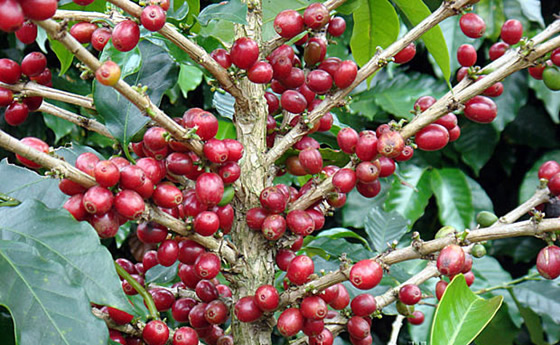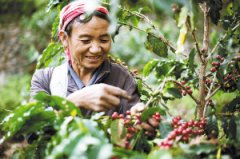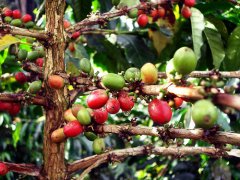Indian coffee flavor Indian monsoon coffee beans
Slippery and delicious coffee with uniform granules.
There are several reasons why Indian coffee is popular with all coffee hobbies, but the most important is a process used in coffee beans, often referred to as the "monsooning" process. In the past, passengers or goods sailed to and from India, which took about several months to reach Europe. During the transportation, due to the high humidity in the air, the taste and color of the raw coffee beans changed. By the time they arrived at the destination, the coffee beans had changed from the original green to a strange yellow.
Consumers are getting used to this, so when steamships shorten the journey time, coffee producers find that consumers still want beans of the same color and taste that are affected by long trips. In order to recreate the flavor of the original coffee, the "monsoon" process was used. In May and June every year, monsoons occur in southwestern India, so during the monsoon season, people spread coffee in special rooms open around them, about 12 to 20 centimeters thick, and leave them there for five days. Rake the coffee beans again and again so that all the coffee beans are exposed to the extremely humid air at that time Then put the curry beans loosely in bags and pile them up so that the monsoon can blow through the bags. The bags are reloaded and piled once a week for seven weeks until the coffee beans change color and taste. Finally, the coffee beans are hand-picked, those that are not affected by the "monsoon" are removed, and then bagged for export. October to February is a good time to make "monsoon" coffee.
In addition to Karnataka, good coffee is grown in Tellichery and Maral in the southwestern state of Kerala, as well as in Nilgiris in the southeastern state of Tamil Nadu, formerly known as Madras.
The best Indian coffee is also classified as Arabian plantation coffee, with the best grades A, B, C and T. The "monsoon" coffee is divided into high-quality Malabar (Monsooned MalabarAA grade coffee) and "monsoon" Basan Nicoli (Monsooned Basanically) coffee. India also produces some bean-shaped berry coffee.
At present, the problems facing the coffee industry are serious bureaucracy, excessive taxes and lack of investment. Currently, the Coffee Council of India (Indian Cffee Board) controls the entire coffee industry, buying coffee and then selling it. Coffee is sold at mass auctions. These coffees are mixed together to reach a certain trade volume, which eliminates the differences between manors and regions, so that many high-quality coffee producers lack sufficient motivation to produce unique and high-quality coffee beans. The government tried to solve this problem in 1992, and through efforts, the famous Valley Nuggets coffee was obtained through seeds from A-grade coffee plantations in several high-quality coffee production areas. People hope this will encourage other coffee growers, because most of them are really eager to put their products into the gourmet coffee market.

Important Notice :
前街咖啡 FrontStreet Coffee has moved to new addredd:
FrontStreet Coffee Address: 315,Donghua East Road,GuangZhou
Tel:020 38364473
- Prev

Yunnan Coffee flavour Coffee beans grown in China
The western and southern parts of Yunnan Province are located between 15 N and the Tropic of Cancer, most of which are 1000-2000 meters above sea level. The topography is dominated by mountains and slopes, with large ups and downs, fertile soil, sufficient sunshine, rich rainfall and large temperature difference between day and night. These unique natural conditions form the special taste of Yunnan small-grain coffee, which is strong but not bitter, fragrant but not strong, slightly fruity. As early as fifty years
- Next

Indonesian coffee is refreshing and ready to drink.
Coffee that makes you feel refreshed and ready to drink. Coffee is produced throughout Indonesia (Indonesia), and Java occupies an extremely important position in coffee history. In the mid-17th century, coffee trees were introduced to Indonesia by the Dutch (some official sources believe that earlier). The first batch of coffee from Java was sold to Amsterdam in 1712. However, in 1877
Related
- Does Rose Summer choose Blue, Green or Red? Detailed explanation of Rose Summer Coffee plots and Classification in Panamanian Jade Manor
- What is the difference between the origin, producing area, processing plant, cooperative and manor of coffee beans?
- How fine does the espresso powder fit? how to grind the espresso?
- Sca coffee roasting degree color card coffee roasting degree 8 roasting color values what do you mean?
- The practice of lattes: how to make lattes at home
- Introduction to Indonesian Fine Coffee beans-- Java Coffee producing area of Indonesian Arabica Coffee
- How much will the flavor of light and medium roasted rose summer be expressed? What baking level is rose summer suitable for?
- Introduction to the characteristics of washing, sun-drying or wet-planing coffee commonly used in Mantenin, Indonesia
- Price characteristics of Arabica Coffee Bean Starbucks introduction to Manning Coffee Bean Taste producing area Variety Manor
- What is the authentic Yega flavor? What are the flavor characteristics of the really excellent Yejasuffi coffee beans?

